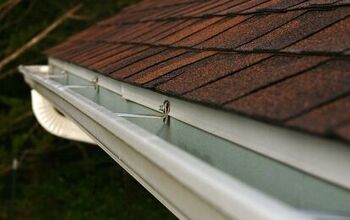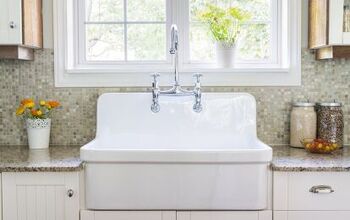Gutter Apron Vs. Drip Edge: What Are The Major Differences?

Drip edges and gutter aprons are essential when installing a roof system. It’s also applicable to gutter systems. This will have an impact on the effectiveness of your entire gutter system if it is not built properly.
By channeling all of the water from the attic into the gutter, a drip edge or gutter apron keeps your roof stable. This prevents rotting and leaks on your roof. The only significant difference between the drip edge and gutter apron is that they both are shaped differently, and they are placed in different ways.
We will discuss this matter further in this article so you know exactly whether you need a gutter apron or a drip edge.
Do You Need Roofing, Siding, or Gutter Installers?
Get free, zero-commitment quotes from pro contractors near you.

What Is A Drip Edge?
The drip edge is installed on the house roof’s edge to filter all water from the roof system. All water is directed away from the fascia and into the gutter. Drip edges are typically provided in a ‘T’ form. D-metal is another name for them.
Drip edges are largely galvanized, and the polymers and metals are non-corroding. They come in a variety of hues to match the color scheme of your home. L-style, T-style, and C-style are the most frequent flashing designs.
Material Types Of Drip Edges
This D-metal is made up of different materials such as:
- Plastic and Vinyl flashing
- Copper drip edge
- House wrap
- Aluminum
- Fiberglass drip edge
- Galvanized Steel Material
The 2012 International Building Codes made drip edge a requirement for shingle roofs (IBS). And it needs to be since it provides excellent protection for your timber. A wooden attic, particularly one with shingles, is prone to decay and mildew.
Advantages Of Drip Edge
Let’s take a look at a few of its perks, as there are so many.
Fascia Guard
Due to prolonged exposure to water, your fascia, or roofline, can be severely damaged. Roof leakage, decay, and discoloration are examples of this damage. A drip edge, on the other hand, just directs the flow of water into your main gutter.
For instance, if your shingle roof is curling. The shingles’ edges will be pointing downward. As a result, any water that falls onto your fascia board will cause it to get saturated. However, if a drip edge is built along the shingles’ border, the water will flow towards the gutter.
Protects From Wind And Rain
The heavy and violent wind forces water to the corners and cracks of the roofs under extreme weather conditions. You should be conscious of gravity in this situation. Consider the effect of little water drops on metal flashing. Without a pump, how do they flow directly to the gutter?
Isn’t gravity the answer? Because there is no drip edge gravity to drag rainfall into the gutter, a strong breeze will blow rainwater onto your roof.
Insects Protection
One of the most significant advantages of drip edge is that it protects your home from insect infestation. It merely protects a gap left by a carpenter in your home.
The gap between your deck and fascia board is referred to as the void. Yes, that large opening can be a way for a lot of pests to get into your house. By penetrating deep into the wood cavity, these tiny pests can also cause damage to your roof.
Basement Protection
A drip edge will help protect the ground just beneath the rooftop. It protects water leaking to the ground beneath the fascia by directing it away from it and into the gutter.
A basement is frequently found beneath that ground. Water can simply enter the ground and subsequently into your basement without a drip edge flashing.
Attic Stabilization
It is very usual for homeowners to file a claim for roof damage with their insurance company. The roof’s instability is the primary reason behind this. Heavy winds, moisture, ice dams, and precipitation all contribute to this instability.
A drip edge stabilizes your roof during a harsh winter by limiting ice dam formation and water movement towards your roof. It accomplishes this by preventing water from leaking into cracks.
Drawback Of Drip Edge
Drip edge has the disadvantage of having code specifications. You can’t just slap it on any old roof edge. If you’re not sure what drip edge requirements are, seek professional assistance. Some key norms of conduct
The drip edge comes in lengths of ten feet. The overlap between joined portions must be at least 51mm. For 6.4mm and 51mm for a roof deck, this metal drip edge should extend beyond the roof casing.
However, the fact that it has pre-defined standards is also a plus. It can spare you the headache of having to buy a metal flashing over and over again.
Gutter Apron
You’ve learned everything there is to know about drip edge! The function of a gutter apron is similar to that of a drip edge, but the material and shape are different.
Instead of being shaped like a T, they are shaped like an L. Although gutter aprons are similar to flashing metals, they are often utilized on low-slope roofs.
Rainwater from your roof runs directly into the gutter with gutter aprons. It also helps to keep the roof wood from decaying and being damaged by water. A gutter apron also prevents water from entering the gutter from behind it.
You could be wondering if gutter aprons and drip edge are composed of the same materials. Metal strips, such as aluminum and steel sheets, are also used as aprons flashing. They also come in a variety of colors and sizes. White, black, brown, and bronze are the most common hues for gutter aprons.
Advantages Of Gutter Apron
The gutter apron has various benefits and is an outstanding roof system option! Exceptional Defense It protects the attic from deterioration. It will keep your house safe during storms by channeling rainwater directly into a gutter.
It also protects your roof deck, gaps, and fascia by preventing water from entering. Gutter aprons are constructed of galvanized metal that allows water to flow freely into the gutter.
A Worthwhile Investment
Aren’t you saving money in the long run by choosing a gutter apron for your roof? This is an easy concept to grasp. Your roof will be exposed to environmental conditions such as excess wetness from rainwater or wind-driven water if gutter aprons are not installed.
Your roof may become fully cracked, requiring you to re-roof your home. Of course, I’m going to spend a lot of money again. Installing gutter aprons will save you from all of that trouble.
Less Maintenance
If you simply add a gutter apron with your roof, you will require less maintenance. This will capture all of the rainwater and prevent it from penetrating deeply.
If you didn’t build a gutter apron, for example, you’ll have to collect and clean rainwater from your attic. It will take time and will not be 100 percent effective. So, to save yourself a lot of aggravation, build a gutter apron.
Drawback Of Gutter Apron
It also has code requirements that vary depending on the roof’s style and borders. It can’t be put on top of an existing roof. If the gutter is distant from the shingles’ edge, a gutter apron is not necessary.
Do You Need Roofing, Siding, or Gutter Installers?
Get free, zero-commitment quotes from pro contractors near you.

Difference Between Gutter Apron vs Drip Edge
We’ll compare the primary distinctions between the gutter apron and the drip edge after we’ve learned everything there is to know about each one. Make sure you don’t forget any of the facts.
Installation
On the corners of the roof decking, a gutter apron is built. It is installed beneath the shingles of an attic to guide water into the gutter.
A drip edge, on the other hand, is attached to the trim and normally hangs straight beyond the gutter. When shingles aren’t far enough from the gutter’s edge, a gutter apron is employed.
It is suggested that you get professional counsel before making your decision. Depending on the style and roof of your ideas, they can serve a variety of functions.
If your attic is planned with a lot of sides and curved edges, a gutter apron is a better choice than a drip edge. The curving edge sides of a drip edge might be visible.
When installing a drip edge, make sure it’s aligned to funnel water into the gutter alongside the roof edges. Nails can be used to firmly secure it. Nails should be spaced roughly every 12 inches in the ideal situation. It should not be more than 16 inches long.
Durability
Both gutter aprons and drip edges should be able to withstand UV radiation as well as wetness. If your gutter apron isn’t installed correctly, you’ll have to look into other roofing solutions.
Drip edge, on the other hand, is available in a variety of forms and can be re-installed on the roof. They’re both composed of the same materials, such as aluminum and steel, and they’re both very durable.
Installation On Existing Roof
Before constructing a roof structure, any type of flashing should always be installed. However, saving your newly created roof from water is not difficult. Use a drip edge when putting on an existing roof. It’s simple to add a drip edge, and there’s no need to lift the shingles.
Cost Difference
There isn’t much of a difference in price between the two. They accomplish the same goal and are quite affordable. The cost varies based on the type of material and length chosen. However, it is expected that each linear foot installation will cost between $1 and $3.
They are highly cost-effective because some roofers will not charge an additional fee to install them. So, if you want to do it yourself for your gratification, you certainly may. However, you should always choose an expert who is knowledgeable in designs, settings, and appropriate folding.

Heather is a passionate writer who loves anything DIY. Growing up, she learned everything from home repairs to design, and wants to share her tips with you. When she's not writing, she's usually hiking or searching for her next DIY project.
More by Heather Robbins



























